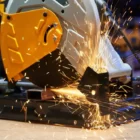Choosing the appropriate saw blade is determined by the specific needs of the project. If an incorrect tooth configuration is selected, the life of the saw blade will be significantly reduced.
Number of threads per inch (2.54 cm)
The number of teeth at 2.54 centimeters is coded as “TPI”. This number varies between 1-32. The higher the TPI number, the finer the tooth pitch of the saw. Thin materials should be cut with saws with fine tooth pitch. For soft materials such as aluminum, it is necessary to use saws with large tooth pitch.
In general, if the gap between the teeth is large, debris and burrs go away easily, but closer teeth provide a smoother surface.
You can use the TPI tables below to give you an idea.
TPI Selection for Round Hard Metals
| TPI (teeth per inch) | 24 | 14 | 10/14 | 8/14 | 6/10 | 5/8 | 4/6 | 3/4 | 2/3 |
|---|---|---|---|---|---|---|---|---|---|
| Material Thickness (inch) | 0.08 | 0.3 | 0.4 | 0.6 | 0.8 | 1.0 | 2.0 | 5.0 | 10.0 |
| Mater | 2 | 7 | 10 | 15 | 20 | 25 | 50 | 127 | 254 |
TPI Selection for Tubes, Pipes, Profiles
| TPI (teeth per inch) | 14 | 10/14 | 8/12 | 6/10 | 5/8 | 4/6 | 3/4 | 2/3 | 1.1/1.5 |
| Material Thickness (inch) | 0.08 | 0.1 | 0.15 | 0.2 | 0.3 | 0.6 | 1.06 | 2.0 | |
| Mater | 2 | 2.5 | 4 | 5 | 7 | 15 | 27 | 50 |
Band saw blades have 5 different tooth figurations
1- Regular tooth saw blades
The teeth are evenly spaced along the saw blade. Where one tooth ends, another tooth begins. Regular tooth saws are commonly used. They are straight teeth with deep grooves. These types of saws are used for both contouring and cutting. It is a type of general purpose saw blade for thin metals.
2- Hook tooth saw blades
The hook-like teeth are widely spaced and inclined at 10°. Hook-type saw blades with large teeth and deep grooves are suitable for rough and long cuts. Used for hard non-ferrous alloys.
3- Wavy toothed saw blades
The teeth are not aligned perfectly straight. In this saw, right and left angled tooth groups come together. Suitable for cutting thin sheets, pipes and metals.
4- Variable tooth saw blades
In this type, teeth of different sizes and settings come together. Variable angles and grooves reduce vibration. For smooth and fast cuts, this saw is preferred for cutting bevels.
5- Skip-tooth saw blades
In the skipping tooth figuration, there is a gap next to one tooth, then there is the other tooth. Suitable for non-ferrous metals. This gap prevents the saw from clogging; It helps to clean the burrs and cut the saw faster. It becomes a little difficult to obtain a smooth surface with this type of saw teeth.





